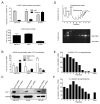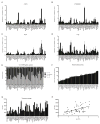The major reverse transcriptase-incompetent splice variant of the human telomerase protein inhibits telomerase activity but protects from apoptosis
- PMID: 23610451
- PMCID: PMC3643995
- DOI: 10.1158/0008-5472.CAN-12-3082
The major reverse transcriptase-incompetent splice variant of the human telomerase protein inhibits telomerase activity but protects from apoptosis
Abstract
Human telomerase reverse transcriptase (hTERT; the catalytic protein subunit of telomerase) is subjected to numerous alternative splicing events, but the regulation and function of these splice variants is obscure. Full-length hTERT includes conserved domains that encode reverse transcriptase activity, RNA binding, and other functions. The major splice variant termed α+β- or β-deletion is highly expressed in stem and cancer cells, where it codes for a truncated protein lacking most of the reverse transcriptase domain but retaining the known RNA-binding motifs. In a breast cancer cell panel, we found that β-deletion was the hTERT transcript that was most highly expressed. Splicing of this transcript was controlled by the splice regulators SRSF11, HNRNPH2, and HNRNPL, and the β-deletion transcript variant was associated with polyribosomes in cells. When ectopically overexpressed, β-deletion protein competed for binding to telomerase RNA (hTR/TERC), thereby inhibiting endogenous telomerase activity. Overexpressed β-deletion protein localized to the nucleus and mitochondria and protected breast cancer cells from cisplatin-induced apoptosis. Our results reveal that a major hTERT splice variant can confer a growth advantage to cancer cells independent of telomere maintenance, suggesting that hTERT makes multiple contributions to cancer pathophysiology.
Conflict of interest statement
The authors disclose no potential conflicts of interest.
Figures







References
-
- Blackburn EH. Telomere states and cell fates. Nature. 2000;408:53–6. - PubMed
-
- Harley CB, Futcher AB, Greider CW. Telomeres shorten during ageing of human fibroblasts. Nature. 1990;345:458–60. - PubMed
-
- Kim NW, Piatyszek MA, Prowse KR, Harley CB, West MD, Ho PL, et al. Specific association of human telomerase activity with immortal cells and cancer. Science. 1994;266:2011–5. - PubMed
-
- Meyerson M, Counter CM, Eaton EN, Ellisen LW, Steiner P, Caddle SD, et al. hEST2, the putative human telomerase catalytic subunit gene, is up-regulated in tumor cells and during immortalization. Cell. 1997;90:785–95. - PubMed
-
- Sykorova E, Fajkus J. Structure-function relationships in telomerase genes. Biol Cell. 2009;101:375–92. 1 p following 92. - PubMed
Publication types
MeSH terms
Substances
Grants and funding
LinkOut - more resources
Full Text Sources
Other Literature Sources
Medical

